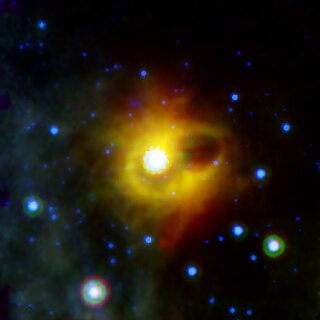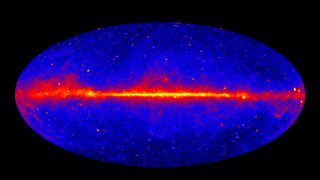Related Research Articles

A neutron star is the collapsed core of a massive supergiant star, which had a total mass of between 10 and 25 solar masses (M☉), possibly more if the star was especially metal-rich. Except for black holes, neutron stars are the smallest and densest known class of stellar objects. Neutron stars have a radius on the order of 10 kilometers (6 mi) and a mass of about 1.4 M☉. They result from the supernova explosion of a massive star, combined with gravitational collapse, that compresses the core past white dwarf star density to that of atomic nuclei.

In physics, radiation is the emission or transmission of energy in the form of waves or particles through space or a material medium. This includes:

X-ray astronomy is an observational branch of astronomy which deals with the study of X-ray observation and detection from astronomical objects. X-radiation is absorbed by the Earth's atmosphere, so instruments to detect X-rays must be taken to high altitude by balloons, sounding rockets, and satellites. X-ray astronomy uses a type of space telescope that can see x-ray radiation which standard optical telescopes, such as the Mauna Kea Observatories, cannot.

In gamma-ray astronomy, gamma-ray bursts (GRBs) are immensely energetic explosions that have been observed in distant galaxies, described by NASA as "the most powerful class of explosions in the universe". They are the most energetic and luminous electromagnetic events since the Big Bang. Bursts can last from ten milliseconds to several hours. After an initial flash of gamma rays, a longer-lived "afterglow" is usually emitted at longer wavelengths.

A solar flare is a relatively intense, localized emission of electromagnetic radiation in the Sun's atmosphere. Flares occur in active regions and are often, but not always, accompanied by coronal mass ejections, solar particle events, and other eruptive solar phenomena. The occurrence of solar flares varies with the 11-year solar cycle.

A magnetar is a type of neutron star with an extremely powerful magnetic field (~109 to 1011 T, ~1013 to 1015 G). The magnetic-field decay powers the emission of high-energy electromagnetic radiation, particularly X-rays and gamma rays.

SGR 1806−20 is a magnetar, a type of neutron star with a very powerful magnetic field, that was discovered in 1979 and identified as a soft gamma repeater. SGR 1806−20 is located about 13 kiloparsecs (42,000 light-years) from Earth on the far side of the Milky Way in the constellation of Sagittarius. It has a diameter of no more than 20 kilometres (12 mi) and rotates on its axis every 7.5 seconds (30,000 kilometres per hour (19,000 mph) rotation speed at the surface). As of 2016, SGR 1806-20 is the most highly magnetized object ever observed, with a magnetic field over 1015 gauss (G) (1011 tesla) in intensity (compared to the Sun's 1–5 G and Earth's 0.25–0.65 G).

A radio-quiet neutron star is a neutron star that does not seem to emit radio emissions, but is still visible to Earth through electromagnetic radiation at other parts of the spectrum, particularly X-rays and gamma rays.

Gamma-ray burst progenitors are the types of celestial objects that can emit gamma-ray bursts (GRBs). GRBs show an extraordinary degree of diversity. They can last anywhere from a fraction of a second to many minutes. Bursts could have a single profile or oscillate wildly up and down in intensity, and their spectra are highly variable unlike other objects in space. The near complete lack of observational constraint led to a profusion of theories, including evaporating black holes, magnetic flares on white dwarfs, accretion of matter onto neutron stars, antimatter accretion, supernovae, hypernovae, and rapid extraction of rotational energy from supermassive black holes, among others.
SGR 0526−66 is a soft gamma repeater (SGR), located in the Super-Nova Remnant (SNR) 0526−66.1, otherwise known as N49, in the Large Magellanic Cloud. It was the first soft gamma repeater discovered, and as of 2015, the only known located outside our galaxy. First detected in March 1979, it was located by using the measurement of the arrival time differences of the signal by the set of artificial satellites equipped with gamma ray detectors. The association with N49 can only be indirect: it seems clear that soft gamma repeaters form in young stellar clusters. It is not certain that the explosion that gave birth to SGR 0525-66 is also the one that produced the remnant N49.

SGR 1900+14 is a soft gamma repeater (SGR), located in the constellation of Aquila about 20,000 light-years away. It is assumed to be an example of an intensely magnetic star, known as a magnetar. It is thought to have formed after a fairly recent supernova explosion.
SGR 1627−41, is a soft gamma repeater (SGR), located in the constellation of Ara. It was discovered June 15, 1998 using the Burst and transient Source Experiment (BATSE) and was the first soft gamma repeater to be discovered since 1979. During a period of 6 weeks, the star bursted approximately 100 times, and then went quiet. The measured bursts lasted an average of 100 milliseconds, but ranged from 25 ms to 1.8 seconds. SGR 1627−41 is a persistent X-ray source. It is located at a distance of 11 kpc in the radio complex CTB 33, a star forming region that includes the supernova remnant G337.0-0.1.

A gamma ray, also known as gamma radiation (symbol
γ
), is a penetrating form of electromagnetic radiation arising from the radioactive decay of atomic nuclei. It consists of the shortest wavelength electromagnetic waves, typically shorter than those of X-rays. With frequencies above 30 exahertz (3×1019 Hz) and wavelength less than 10 picometer (1×10−11 m) gamma ray photons have the highest photon energy of any form of electromagnetic radiation. Paul Villard, a French chemist and physicist, discovered gamma radiation in 1900 while studying radiation emitted by radium. In 1903, Ernest Rutherford named this radiation gamma rays based on their relatively strong penetration of matter; in 1900 he had already named two less penetrating types of decay radiation (discovered by Henri Becquerel) alpha rays and beta rays in ascending order of penetrating power.
SGR J1550−5418 is a soft gamma repeater (SGR), the sixth to be discovered, located in the constellation Norma. Long known as an X-ray source, it was noticed to have become active on 23 October 2008, and then after a relatively quiescent interval, became much more active on 22 January 2009. It has been observed by the Swift satellite, and by the Fermi Gamma-ray Space Telescope, launched in 2008, as well as in X-ray and radio emission. It has been observed to emit intense bursts of gamma rays at a rate of up to several per minute. At its estimated distance of 30,000 light years, the most intense flares equal the total energy emission of the Sun in ~20 years.

Gamma-ray astronomy is the astronomical observation of gamma rays, the most energetic form of electromagnetic radiation, with photon energies above 100 keV. Radiation below 100 keV is classified as X-rays and is the subject of X-ray astronomy.
SGR 0501+4516 is a magnetar that is a soft gamma repeater (SGR). Currently, the phenomenons of SGRs and the related Anomalous X-ray pulsars (AXP) are explained as arising from magnetars. SGR 0501+4516 is located approximately 15,000 light years from Earth and has a magnetic field 100 trillion times stronger than the Earth's.

Astrophysical X-ray sources are astronomical objects with physical properties which result in the emission of X-rays.
GRB 790305b is an event that took place on 5 March 1979. It was an extremely bright burst that was successfully localized to supernova remnant N49 in the Large Magellanic Cloud. This event is now interpreted as a magnetar giant flare, more related to SGR flares than "true" gamma-ray bursts. It is the first observed SGR megaflare, a specific type of short GRB. It has been associated with the magnetar PSR B0525-66.

SGR 1935+2154 is a soft gamma repeater (SGR) that is an ancient stellar remnant, in the constellation Vulpecula, originally discovered in 2014 by the Neil Gehrels Swift Observatory. Currently, the SGR-phenomena and the related anomalous X-ray pulsars (AXP) are explained as arising from magnetars. On 28 April 2020, this remnant about 30,000 light-years away in our Milky Way galaxy was observed to be associated with a very powerful radio pulse known as a fast radio burst or FRB, and a related x-ray flare. The detection is notable as the first FRB detected inside the Milky Way, and the first to be linked to a known source. Later in 2020, SGR 1935+2154 was found to be associated with repeating fast radio bursts.
References
- ↑ Zhang, Bing; Xu, R.X.; Qiao, G.J. (2000). "Nature and Nurture: a Model for Soft Gamma-Ray Repeaters". The Astrophysical Journal. 545 (2): 127–129. arXiv: astro-ph/0010225 . Bibcode:2000ApJ...545L.127Z. doi:10.1086/317889. S2CID 14745312.
- 1 2 3 4 Duncan, Robert C. (May 1998). "The March 5th Event". Magnetars', Soft Gamma Repeaters & Very Strong Magnetic Fields. University of Texas at Austin . Retrieved March 2, 2009.
- 1 2 3 4 Dooling, Dave (May 20, 1998). ""Magnetar" discovery solves 19-year-old mystery". NASA. Archived from the original on March 11, 2009. Retrieved March 2, 2009.
- ↑ "McGill SGR/AXP Online Catalog".
- ↑ "Star Emits Intense Celestial Fireworks". Space.com. 10 February 2009.
- ↑ "Giant eruption reveals 'dead' star". European Space Agency. 16 June 2009. Retrieved 28 December 2009.